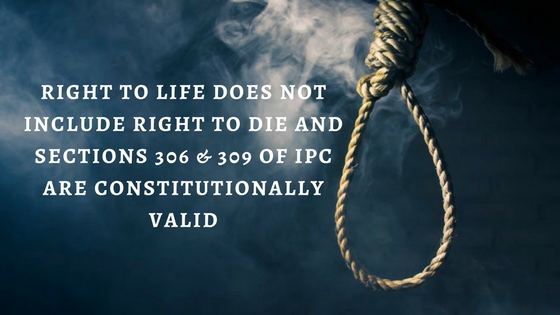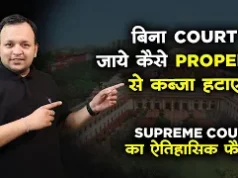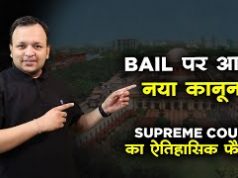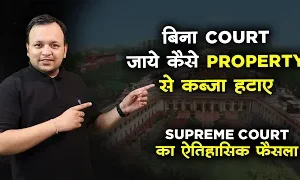
Aapka Consultant Judgment Series- In this series, we are providing case analysis of Landmark Judgments of Hon’ble Supreme Court of India.
Smt. Gian Kaur Vs. State of Punjab
AIR1996SC946, (1996)2SCC648, [1996]3SCR697
Hon’ble Judges/Coram: J.S. Verma, G.N. Ray, N.P. Singh, Faizanuddin and G.T. Nanavati, JJ.
Date of Decision: 21.03.1996
FACTS:-
The appellants Gian Kaur and her husband Harbans Singh were convicted by the Trial Court under Section 306, Indian Penal Code, 1860 (for short “IPC”) and each sentenced to six years Rigorous Imprisonment and fine of Rs. 2,000, or in default, further R.I for nine months, for abetting the commission of suicide by Kulwant Kaur. On appeal to the High Court, the conviction of both has been maintained but the sentence of Gian Kaur alone has been reduced to R.I. for three years. These appeals by special leave are against their conviction and sentence under Section 306, IPC. The conviction of the appellants has been assailed, inter alia, on the ground that Section 306, IPC is unconstitutional. The first argument advanced to challenge the constitutional validity of Section 306, IPC rests on the decision in P. Rathinam v. Union of India and Anr. 1994CriLJ1605, by a Bench of two learned Judges of this Court wherein Section 309, IPC has been held to be unconstitutional as violative of Article 21 of the Constitution. It is urged that ‘right to die’ being included in Article 21 of the Constitution as held in P. Rathinam declaring Section 309, IPC to be unconstitutional, any person abetting the commission of suicide by another is merely assisting in the enforcement of the fundamental right under Article 21; and, therefore, Section 306, IPC penalising assisted suicide is equally violative of Article 21. This argument, it is urged, is alone sufficient to declare that Section 306, IPC also is unconstitutional being violative of Article 21 of the Constitution. In view of the significance of this contention involving a substantial question of law as to the interpretation of Article 21 relating to the constitutional validity of Section 306, I.P.C. which requires reconsideration of the decision in P. Rathinam, the Division Bench before which these appeals came up for hearing has referred the matter to a Constitution Bench for deciding the same. This is how the matter comes before the Constitution Bench.
ISSUES:-
- Whether the scope of Article 21also includes the ‘right to die’?
- Whether the Sections 309 and 306 of the Indian Penal Code are unconstitutional?
JUDGMENT:-
In P. Rathinam it was held that the scope of Article 21 includes the ‘right to die’. P. Rathinam held that Article 21 has also a positive content and is not merely negative in its reach. Reliance was placed on certain decisions to indicate the wide ambit of Article 21 wherein the term ‘life’ does not mean ‘mere animal existence’ but ‘right to live with human dignity’ embracing quality of life. Drawing analogy from the interpretation of ‘freedom of speech and expression’ to include freedom not to speak, ‘freedom of association and movement’ to include the freedom not to join any association or to move anywhere, ‘freedom of business’ to include freedom not to do business, it was held in P. Rathanam that logically it must follow that right to live would include right not to live, i.e., right to die or to terminate one’s life. Having concluded that Article 21 includes also the right to die, it was held that Section 309, IPC was violative of Article 21. This is the only basis in P. Rathinam to hold that Section 309, IPC is unconstitutional.
After perusal of the judgment in P. Rathinam case, it is clear that in substance the reason for that view is, that if a person has right to live, he also has a right not to live. The decisions relied on for taking that view relate to other fundamental rights which deal with different situations and different kind of rights. In those cases the fundamental right is of a positive kind, for example, freedom of speech, freedom of association, freedom of movement, freedom of business etc. which were held to include the negative aspect of their being no compulsion to exercise that right by doing the guaranteed positive act. Those decisions merely held that the right to do an act includes also the right not to do an act in that manner. It does not flow from those decisions that if the right is for protection from any intrusion thereof by others or in other words the right has the negative aspect of not being deprived by others of its continued exercise e.g. the right to life or personal liberty, then the converse positive act also flows there from to permit expressly its discontinuance or extinction by the holder of such right. In those decisions it is the negative aspect of the right that was invoked for which no positive or overt act was required to be done by implication. This difference in the nature of rights has to be borne in mind when making the comparison for the application of this principle.
When a man commits suicide he has to undertake certain positive overt acts and the genesis of those acts cannot be traced to, or be included within the protection of the ‘right to life’ under Article 21. The significant aspect of ‘sanctity of life’ is also not to be overlooked. Article 21 is a provision guaranteeing protection of life and personal liberty and by no stretch of imagination can ‘extinction of life’ be read to be included in ‘protection of life’. Whatever may be the philosophy of permitting a person to extinguish his life by committing suicide, it is difficult to construe Article 21 to include within it the ‘right to die’ as a part of the fundamental right guaranteed therein. ‘Right to life’ is a natural right embodied in Article 21 but suicide is an unnatural termination or extinction of life, and therefore, incompatible and inconsistent with the concept of ‘right to life’. With respect and in all humility, there is no similarity in the nature of the other rights, such as the right to ‘freedom of speech’ etc. to provide a comparable basis to hold that the ‘right to life’ also includes the ‘right to die’. With respect, the comparison is inapposite, for the reason indicated in the context of Article 21. The decisions relating to other fundamental rights wherein the absence of compulsion to exercise a right was held to be included within the exercise of that right, are not available to support the view taken in P. Rathinam qua Article 21.
To give meaning and content to the word ‘life’ in Article 21, it has been construed as life with human dignity. Any aspect of life which makes it dignified may be read into it but not that which extinguishes it and is, therefore, inconsistent with the continued existence of life resulting in effacing the right itself. The ‘right to die’, if any, is inherently inconsistent with the ‘right to life’ as is ‘death’ with ‘life’. The ‘right to life’ including the right to live with human dignity would mean the existence of such a right up to the end of natural life. This also includes the right to a dignified life up to the point of death including a dignified procedure of death. In other words, this may include the right of a dying man to also die with dignity when his life is ebbing out. But the ‘right to die’ with dignity at the end of life is not to be confused or equated with the ‘right to die’ an unnatural death curtailing the natural span of life.
A question may arise, in the context of a dying man, who is, terminally ill or in a persistent vegetative state that he may be permitted to terminate it by a premature extinction of his life in those circumstances. This category of cases may fall within the ambit of the ‘right to die’ with dignity as a part of right to live with dignity, when death due to termination of natural life is certain and imminent and the process of natural death has commenced. These are not cases of extinguishing life but only of accelerating conclusion of the process of natural death which has already commenced. The debate even in such cases to permit physician assisted termination of life is inconclusive. It is sufficient to reiterate that the argument to support the view of permitting termination of life in such cases to reduce the period of suffering during the process of certain natural death is not available to interpret Article 21 to include therein the right to curtail the natural span of life.
Therefore, this Court is unable to concur with the interpretation of Article 21 made in P. Rathinam. The only reason for which Section 309 is held to be violative of Article 21 in P. Rathinam does not withstand legal scrutiny, and thus, Court holds that Section 309 I.P.C. is violative of Article 21. The question now is whether Section 306, IPC is unconstitutional for any other reason. The challenge to the constitutional validity of Section 309, IPC having been rejected, no serious challenge to the constitutional validity of Section 306 survives. It is significant that Section 306 enacts a distinct offence which is capable of existence independent of Section 309, IPC. Section 306 prescribes punishment for ‘abetment of suicide’ while Section 309 punishes ‘attempt to commit suicide’. Abetment of attempt to commit suicide is outside the purview of Section 306 and it is punishable only under Section 309 read with Section 107, IPC. In certain other jurisdictions, even though attempt to commit suicide is not a penal offence yet the abettor is made punishable. The provision there provides for the punishment of abetment of suicide as well as abetment of attempt to commit suicide. Thus, even where the punishment for attempt to commit suicide is not considered desirable, its abetment is made a penal offence. In other words assisted suicide and assisted attempt to commit suicide are made punishable for cogent reasons in the interest of society. Such a provision is considered desirable to also prevent the danger inherent in the absence of such a penal provision.
HELD:-
In light of the above principles discussed, the Court held that right to life does not right to die, and further, Sections 306 and 309 of Indian Penal Code are constitutionally valid.
To Get Legal Opinion from Advocates/ Legal Experts, Please click here
To Get Legal Opinion from Retired Hon’ble Judges, Please click here











